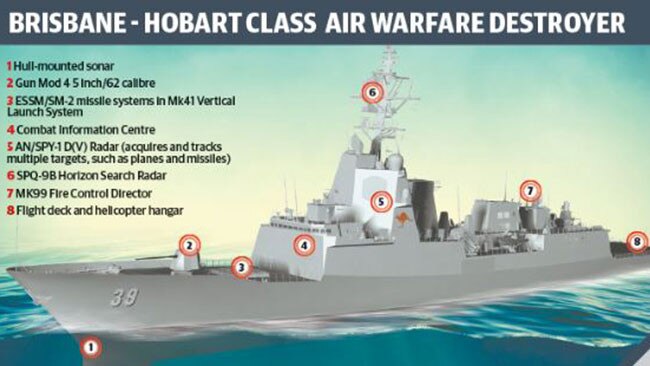Adelaide-built air warfare destroyer Brisbane launches at ASC Osborne
THE second of three Adelaide-built air warfare destroyers has launched in Adelaide — another success for a workforce ridiculed two years ago as unfit to build a canoe. See the ship from above and explore a 3D model
SA News
Don't miss out on the headlines from SA News. Followed categories will be added to My News.
- Made in Adelaide — first Air Warfare Destroyer launched at ASC
- Take a look aboard these extraordinary ships
- HMAS Hobart completes first stage of sea trials
THE second of three Adelaide-built air warfare destroyers has been launched in Adelaide, forging another success for a workforce ridiculed two years ago as unfit to build a canoe.
In a key milestone for the $9 billion project, the Brisbane was lowered into the water at Osborne’s Techport Australia shipyard as part of a formal naming and launching ceremony.
The ship was christened by Robyn Shackleton, who is the wife of former Navy chief Vice Admiral David Shackleton.
Mrs Shackleton, a former Navy nursing officer, cut a rope to release a bottle of South Australian Sparkling Pinot Noir to crack on to the HMAS Brisbane’s hull and officially christen the vessel.
Defence Industry Minister Christopher Pyne congratulated the workforce, from three companies, and branded the launch a “momentous occasion”.
“The construction and integration work occurring here in Adelaide on the AWD (air warfare destroyer) program is a vital part of South Australia’s shipbuilding industry,” he said.

Australia’s most advanced and lethal warships, the 146.7m-long Hobart Class air warfare destroyers, are bristling with hi-tech equipment, including a combat system capable of tracking 100 targets simultaneously.
Combat system equipment will be loaded on to the Brisbane in the next few months as it is tied up at the Osborne shipyard.
Three air warfare destroyers are being built at Osborne as part of an alliance involving shipbuilder ASC, mission systems integrator Raytheon, ship build manager Navantia and the Defence Department.

Mr Pyne in September hailed the first successful sea trials of the first air warfare destroyer, the Hobart, which was launched in May last year.
The Hobart is scheduled to be handed over to the Navy in mid-2017, the Brisbane in September, 2018 and the third ship, Sydney, in March, 2020.
Former defence minister David Johnston in 2014 attacked ASC by declaring he would not trust it to build a canoe.

The project was also rocked by the release, a day before the Hobart’s launch, of scathing federal audit results showing a $1.2 billion, two-to-three-year project blowout.
But it is now meeting revised cost and schedule targets and today was applauded by Defence Personnel Minister Dan Tehan, representing the Federal Government at today’s ceremony.
“I have been on board the first destroyer, Hobart, and it is quite apparent these completed ships will become a valuable asset to the Royal Australian Navy,” he said.
“Australia is undertaking an unprecedented upgrade of its naval capabilities and the addition of Brisbane to our fleet will help ensure our ongoing national security.”
ASC forklift operator Jade Hills said processes to improve speed, quality and cost were improving with every ship.
“I think it’s getting better each time there’s improvement on the last one,” she said.
French firm DCNS expects to start cutting steel in the mid-2020s on the first of 12 submarines to be built at Osborne as part of a $50 billion project.
Work is expected to start in 2020 on the $35 billion project to build nine future frigates at Osborne.
Premier Jay Weatherill congratulated all the workers who had contributed to the Air Warfare Destroyer program.
“The South Australian Government is serious about supporting and growing the defence industry in South Australia. Today’s launch is proof of South Australia’s world-class shipbuilding infrastructure and high-end skills base,” Mr Weatherill said.
“The fact that ships 2 and 3 of the Air Warfare Destroyer program have been able to progress with significant efficiency gains from the first ship demonstrates the benefit of a continuous naval shipbuilding program.”

SA Defence Industries Minister Martin Hamilton-Smith said the Air Warfare Destroyer construction was comparable in size and capability to the Future Frigates.
“So the success of this program is a clear representation that South Australia has the workforce with the skills and capability to undertake the upcoming shipbuilding programs,” he said.
“As another milestone is reached on the Air Warfare Destroyer program, it is a reminder that we must maintain the tempo of shipbuilding programs to retain as much of the skilled workforce as possible for the Offshore Patrol Vessel and Future Frigate programs, due to start in 2018 and 2020 respectively.”



